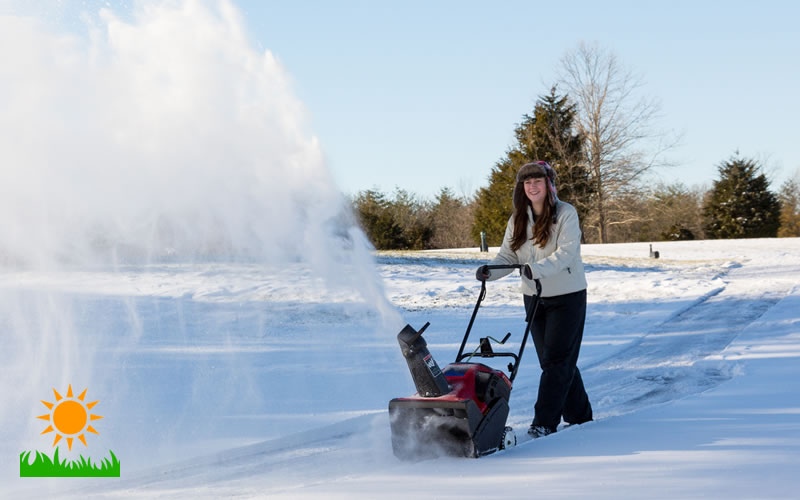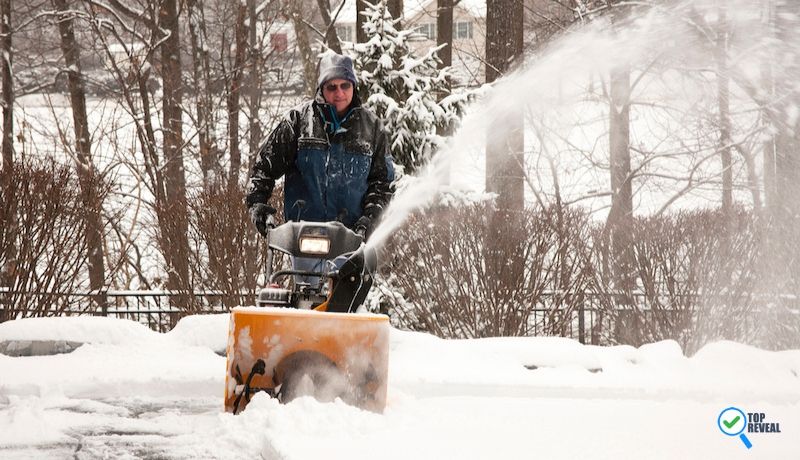A snow blower can be a lifesaver during the winter months if you’re located in an area that experiences moderate to heavy snowfall. They help you to quickly clear driveways, walkways, and more, making them a time and labor-saving alternative to shoveling snow.

However, as great as they are, they are also powerful pieces of equipment to be respected; misusing them can be dangerous to you and those around you.
To keep you safe and your walkways clear, we’ve devised this Snow Blower How-To Guide, telling you everything you need to know in terms of operation, maintenance and safety tips.
Benefits Of A Snow Blower
Lightweight and portable, a snow blower will help you spend less time shivering outside and more time curled up by the fire indoors. But that’s just one of the advantages of owning this machine. Let’s look at some of the benefits that you will enjoy if you use one.
You save time
Timesaving is truly invaluable for the modern person, and I am sure that you will agree with me. You will remove and eliminate the snow from all traffic areas on your property in the shortest possible period when you use a snow blower machine.
A blower removes twice the amount of snow as a shovel, making the job quicker and requiring less go-rounds.
Effortless snow cleaning:
The best things about using a snow blower machine is that no effort is required and they are suitable for virtually all households. You just need to start the machine and steer it. The machine is self-propelled, so you do not have to do much pushing or pulling.
Feel great all winter:
Using a snow blower does not require much effort, so no risk of straining any part of your body especially those with back and joint problem. You will not have to spend many hours outdoors removing the snow and risking a severe cold.
Maintenance Of a Snow Blower
Get your snow blower ready for work by installing a new spark plug, checking the condition of the belts and replacing the belts if you see any cracks, fraying or glazing or notice that chunks are missing.
Replace the spark plug. Repaint any rusted areas and apply a high-quality polymeric car wax to all painted surfaces.
Having a healthy respect for your machine will make it safer and easier for you to clear away those mountains of snow. Here is a YouTube video on how to maintain a snow blower:
[su_youtube url=”https://www.youtube.com/watch?v=_NEaN9s_heg” width=”800″ height=”500″]
Types Of Snow Blower
Now that you see the benefits, let’s sort out the varieties of snow blowers that are available on the market so you can pick the best power tool that’s designed to meet your needs.
Electric snow blowers:
Electric snow blowers are ideal for clearing porches, patios, walkways and small driveways. They use light to moderate snow well and work best when used on paved or smooth surfaces. Electric snow blowers are maintenance free; they eliminate the need for oil changes and fill-ups, more economical and weigh less when compared to the gas-powered snow blower.
Cordless snow blowers:
These high-voltage battery-powered machines feature push-button starts, and they are low maintenance. They are efficient in light, moderate and heavy snow. They don’t require the use of power cord and great for use on driveways and walkways. This battery-powered model has a lower weight than their gas snow blower counterparts, making this model easy to maneuver.
Gas Snow Blowers:
These snow blowers offer good mobility since they’re not attached to a power cord during operation. They typically have higher ability clearing widths snows and intake heights than electric models. This type provides plenty of power and available in single-stage, two-stage, and three-stage gas models.
How To Use A Snow Blower
Clearing snow may seem as simple as switching on your snow blower, but there’s a bit of science involved. Check out the tips we explain below on how to use a snow blower so you’ll be ready when the next storm hits.
Perform a pre-check:

Before you use the snow blower, take a few minutes to inspect your machine. Are the skid shoes, shear pins, and scraper blade installed? Have you cleared all foreign objects from your sidewalks/driveway? Are you wearing appropriate clothes, gloves, and safety glasses? Start up your snow thrower and let it run for a few minutes in a well-ventilated space to warm up before the operation.
Plan your attack:
Decide on a pattern so you won’t have to clear snow from an area twice. Ensure you never blow snow in the direction of houses, cars, or other people. Determine where you want to gather the discharged snow, whether it’s on one side or both sides of the driveway. Note: Wind direction plays a vital role in deciding where to discharge snow.
Plan your route:
Starting in the middle of your driveways, walkways, and blow the snow outward is the best. Remember that if you are snow blowing your yard, you should blow the snow far away from your house and push it to the outer edges of your property.
Use both hands:
Keep both hands on the machine as much as possible once your snow blower is running. This lets you have quicker access to the controls and is safer in case you begin to slip.
Move slowly and steady:
Clearing snow isn’t a race; you could clog the snow blower if you move too fast in the heavy deep snow. Set a regular pace based on the snow conditions, and make slow easy turns.
Adjust your skid shoes:
Keep the machine’s auger from directly hitting your driveway by adjusting the slid shoes. You can set the skid shoes on their lowest setting if you have a paved path.
Wipe Down:
Wipe down your snow blower before you keep it in a garage. Wipe any additional snow off of the snow blower; this will help you from having to deal with any water mess in your garage.
Safety Precautions When Using A Snow Blower
The comings of winter season mean that snow-blowers machine get a workout. Many people are treated in the emergency rooms in every winter for injuries suffered while making use of the snow blowers. Below are a few tips to keep you safe and secure while clearing snow in this upcoming season.
- Ensure you read the operator’s manual and familiarize yourself with the controls.
- Work the snow slowly; there is a lesser chance for clogging if you don’t rush the job.
- Never place your hands in the auger. If the snow blower machine clogs while removing snow
- If the chute is clogged, switch off the engine, and wait for the machine to cool, then use a broom handle or the chute clean-out tool to remove the clog.
- Never refuel the machine while running or if the engine is hot.
Final Thoughts
The best advice when learning to use a new device is to read the owner’s manual for more information on how to operate certain parts and features.
Therefore, when the next winter storm comes, we hope this snow blower maintenance Guide & Safety Tips will get you ready out there to try your snow blowing skills. Make sure you have the right snow blower machine to dig yourself out, so you don’t waste your time and money.
